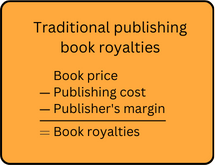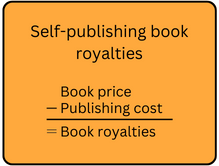Book royalties are payments that authors receive based on a percentage of the sales of their books, typically calculated as a percentage of the cover price or the publisher’s net revenue. With traditional publishers, book royalties are a percentage of the book’s sales revenue paid to the author, typically ranging from 5% to 15%. In self-publishing, authors retain a larger share of the royalties, often receiving 35% to 70% of the book’s list price when using platforms like Amazon KDP.
Book royalties — what are they and how do they work? This comprehensive guide aims to demystify the complicated landscape of book royalties, providing the clarity you need to navigate this essential aspect of your writing career. This post breaks down the complexities of book royalties so you can decide how to publish your book. It will also explore various types of royalties, dive into the factors that influence your earnings and offer practical insights on maximising your income as an author.
- What are book royalties?
- How do book royalties work?
- What factors impact book royalties?
- What are the book royalties under different publishing models?
- How can professional editing improve your chances of earning book royalties?
What are book royalties?
Book royalties are the financial compensation you receive from selling your books. When you publish a book, you enter into a contractual agreement with a publisher or a self-publishing platform. This agreement outlines how your compensation for each copy of the book sold. The concept behind book royalties is straightforward: you earn a percentage of the revenue generated from each book sale. This percentage is usually a fraction of the book’s retail price or the publisher’s net revenue, depending on the terms of the contract.
How do book royalties work?
Book royalties work compensate you for the sales of your books. The process varies depending on the type of book, the publishing method (traditional or self-publishing) and the publishing contract terms. Here is a simplified overview of how book royalties work:
Royalty percentage
The royalty percentage represents the share of revenue you receive for each book sale. This publishing contract determines the percentage. In traditional publishing, it ranges from 5% to 15% or more, depending on various factors, including your prominence as a writer and the book’s format. When readers purchase a book copy, this percentage is applied to the book’s retail price or the publisher’s net revenue to determine the earnings per sale. This allows you to benefit from the commercial success of your literary works directly.
Book price vs net revenue
Choosing between book price and net revenue as the basis for calculating book royalties is critical in publishing contracts. When royalties are calculated based on the book price, you earn a fixed percentage of the book’s retail price, irrespective of discounts or deductions. In contrast, calculating royalties based on net revenue means your percentage is applied to the publisher’s earnings after subtracting various costs, such as discounts, returns, and distribution fees. The book price method offers straightforward and predictable royalties tied to the cover price. At the same time, the net revenue approach can result in lower royalties as it accounts for the publisher’s actual income after expenses.
Sales reporting
Sales reporting is the process through which publishers track and document the sales of books, providing you with detailed royalty statements. These statements include information about the number of copies sold, the royalty rate applied, any deductions such as returns or discounts and the earnings accrued by you during a specific reporting period. Publishers are responsible for compiling and sharing these statements with you to ensure transparency and accountability in the royalty payment process.
Royalty payments
Royalty payments are the monetary compensation you receive from publishers based on the sales of your books. These payments represent your share of the revenue generated by book sales, calculated according to the terms outlined in the publishing contract. Royalty payments are made regularly, often quarterly or semi-annually, based on the number of copies sold and the applicable royalty rate.
Advances
Advances in publishing refer to upfront payments made to you by publishers when they sign a book contract. These payments are a financial advance against your future book royalties. You receive this lump sum before the book is published, providing you with immediate income during the writing and production process. Once the book is published and royalties start coming in, your earned royalties are used to ‘repay’ the advance. You receive additional royalty payments once your earned royalties exceed the advance amount. Advances vary widely depending on your reputation, the book’s potential marketability, and the publisher’s budget.
Ebook and print-on-demand royalties
Ebook and print-on-demand (POD) royalties represent the compensation you receive for sales of digital ebooks and print copies produced on demand. These royalties often differ from traditional print book royalties. Ebook royalties are calculated based on a percentage of the ebook’s sale price. You may earn a higher percentage for ebooks compared to print editions. On the other hand, POD royalties are often based on the net revenue earned from each copy printed, considering factors like printing costs and distribution fees.
What factors impact your book royalties?
Several factors can significantly impact your book royalties. These factors include:
- Publishing method: Whether you choose traditional, self-publishing, or hybrid publishing, your royalty rates and earnings will be affected.
- Book format: The book’s format, such as hardcover, paperback, ebook or audiobook, can lead to varying royalty rates.
- Pricing strategy: The price at which the book is sold to readers can directly influence royalty earnings.
- Royalty rate: The percentage of each sale to the author can vary widely based on publishing method and negotiation.
- Distribution channels: The choice of distribution channels, including online retailers, brick-and-mortar bookstores, and international markets, can impact royalties.
- Publisher’s policies: Traditional publishers often have specific policies on royalties, advances, and sales reporting that affect author earnings.
- Sales volume: The number of copies sold significantly impacts total royalty earnings.
- Return policy: Whether books are returnable by retailers can affect royalty calculations, as returns may result in deductions from total sales.
- Author’s reputation: Established authors with a strong readership and track record may have more negotiating power for higher royalties.
- Genre and market: The genre and target market of the book can influence sales and, consequently, royalty earnings.
- International sales: You may earn different royalties for sales in international markets due to exchange rates and distribution agreements.
- Subsidiary rights: Income from subsidiary rights, such as film adaptations, audiobooks, and foreign translations, can impact overall earnings.
- Advance payments: In traditional publishing, your advance against future royalties affects initial earnings.
What are the book royalties under different publishing models?
Traditional publishing

Royalties offered by traditional publishers vary depending on the format or medium of the book. On average, the author’s royalties from paperback sales equate to 5–7%, hardcover — 15%, and ebook and audiobook — 25%. This range is significantly lower than the 35–70% range offered by the self-publishing platforms (discussed later in this post).
Self-publishing

Unlike traditional publishing , self-publishing offers the highest royalties, the fastest route to market, and complete control and ownership rights. Royalties offered by the PODs may vary depending on the book’s price, format, or country of distribution, ranging between 35% and 70%.
- Amazon KDP: 70% for books priced $2.99–9.99, 35% if below $2.99 or above $9.99.
- Apple Books: 70% royalties.
- Google Play Books: 70% royalties for books sold in over sixty partner countries and 52% in remaining countries.
- Barnes & Noble: 70% royalties for ebooks, 55% for printed books.
| Aspect | Traditional publishing | Self-publishing |
| Rights | The publisher retains book rights | Authors retain all rights |
| Royalties | Vary but typically around 10% | Up to 70% |
| Decisions | The publisher makes most decisions | The author makes all the decisions |
| Timing | It can take up to 2 years or more to publish a book | A book can be published within months |
How can professional editing improve your chances of earning book royalties?
Professional editing services play a pivotal role in enhancing the quality and marketability of a book. Editing can significantly improve the quality and clarity of a text. This is supported by research results. For instance, in this study, 96% of authors who made of over $100,000 on their books chose professional editing services.
- At the initial stage, developmental editing focuses on the big picture — plot structure, character development, pacing and overall narrative coherence. A developmental editor provides valuable insights and suggestions to strengthen the story’s foundation.
- Line editing digs deeper into the prose itself. It seeks to enhance the writing style, language flow, and readability. This type of editing addresses sentence structure and word choice and ensures the text is engaging and impactful.
- Copyediting sharpens the manuscript’s details. Editors scrutinise grammar, punctuation, spelling, and consistency in formatting. It ensures the manuscript adheres to language conventions and maintains a polished appearance.
- Proofreading is the final step, focusing on eliminating any remaining errors or typos. It ensures the manuscript is pristine and ready for publication.
Final thoughts
In sum, as an author, you must grasp the significance of publishing choices, pricing strategies and the impact of sales volume on your earnings. Whether you choose traditional publishing or self-publishing, knowledge of book royalties empowers you to make informed decisions that align with your goals.
If you are getting ready to publish your manuscript, ask me for a free sample edit (and remember to use my early bird discount). I am an experienced editor working with non-fiction, academic and business books.


